The myth of "lasting defense"
Some even formed the opinion that if they could have organized a good defense (like at the Kursk Bulge) at the very beginning of the war, then the enemy would not have been allowed beyond the Dnieper. As a result, the defense in the Soviet Army was put in the first place, in the “Combat Regulations of the Ground Forces” (1989), part of 2 - “Defense”, the head of 3 - “Offensive”. Previously, it was the other way around, the fundamental phrase was removed from the statute: “Offensive combat is the main type of action of the Red Army”.
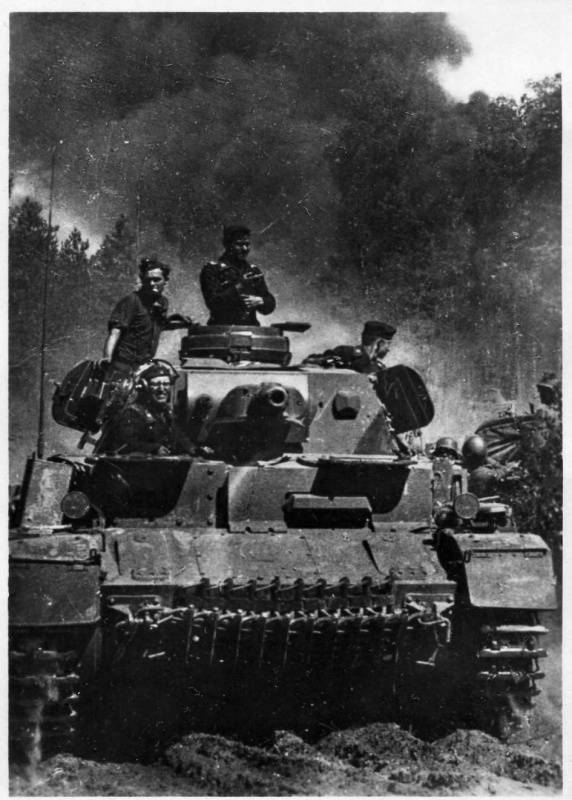
The myth of the senselessness of counterstrikes
In reality, defense, during the Second World War, is almost always inferior to the enemy’s attack: it has the ability to destroy the defenders aviation and mortar and artillery strikes. And most importantly - the unknown plans of the enemy. Where will he strike, when, by what forces, where will the auxiliary strike be?
Intelligence can reveal only part of the enemy’s preparations, mechanized, tank units can travel 60-100 km per night and strike where they are not waiting. The enemy can create 3-5 times superiority over each separate division of the enemy standing in the main strike zone.
And when the battle went into the maneuverable phase, the situation became even more complicated - it was necessary to guess not only the area that would be hit next time, but also the direction of the main attack. This is a very difficult task. It is easier and safer to strike a flank counter attack on it. His flanks are already known, in contrast to finding the attacking "tip", forcing the enemy to protect them, weakens his strike power. Thus, in the border battle, the South-Western Front achieved the greatest success, precisely by inflicting counterstrikes, for example, when DI Ryabyshev’s 8 mechanized corps entered the communications of V. Kempf’s corps in the Dubno area, and did not guess the direction of the main attack in order to build defense.
October 1941 years
In order to create a really solid defense, you need to know the direction of the main attack and the necessary number of troops to create the necessary depth of defense (the famous Battle of Kursk).
A classic example of the defeat of defensive orders is a defensive operation in the Vyazma and Bryansk region in September-October 1941. September 10 troops received the order to "dig deep into the ground," they had three weeks to prepare the defense. Several divisions were withdrawn to the reserve on the Western Front and created a maneuverable group. Transition to trench defense was carried out, before that mainly cells were made - separate entrenchments. Mines were laid on tank-dangerous areas, moats were dug, dugouts were built, firing points were strengthened. But the number one question in defense - where will be the main attack. It was assumed that the Wehrmacht would hit the Smolensk-Yartsevo-Vyazma highway, a defense system with normal density was created here. So, the 112-Infantry Division (SD) occupied the defense of the 8-km and the front with its number of 10 thous. People, the 38-I Infantry Division (these are all parts of the 16-th army of K. K. Rokossovsky) occupied the front in 4 km with 10 number of thousand people. Behind them, and created a reserve strip of defense.
But due to this, other directions were weakened, there was no force for their full-fledged cover. For example, 211 sd (9653 person) occupied the defense on 16 km, 53 sd 43 th army - 24 km. On the Bryansk front, the matter was even worse, the divisions held the front from 24 km to 46 km (217 sd 50 th army). According to the field camp of the Red Army 1939, the division can defend the strip on the front of 8-12 km, in depth to 4-6 km.
An army choosing a defensive strategy is in a much worse position than the attacking side. Only the opening of the direction of the main strike (s) by intelligence provides a chance for success. The Soviet command was working on other possible directions of enemy strikes, but there was no force to reliably close them.
The Germans were able to hide the transfer of the 4 tank group from Leningrad, which made it possible to inflict two main blows in converging directions. Soviet intelligence was able to quite accurately determine the start time of the operation "Typhoon", but did not reveal the direction of attacks. The 3-I tank group struck north of the Yartsevo-Vyazma highway, into the junction of the 19 and 30 armies, the 4-I tank group south of the highway, and 24 and 43 armies east of Roslavl. The Germans created a complete local advantage (4 Germans were against 30's X divisions, 12 tank and 3 were motorized) and broke through the defenses of the Soviet troops, around 1 thousand people were surrounded.
They also broke through the defense of the Bryansk front, waited for the main attack in the Bryansk direction, and the Wehrmacht struck 120-150 km to the south.
Thus, passive waiting led to terrible consequences, unexpected moves by the enemy led to the failure of the defensive strategy. Envisage all moves of the attacking enemy is almost impossible. The only way out is to intercept a strategic initiative, at any cost. This principle is true in both war and hand-to-hand combat, the best defense is attack.
No need to think that the Wehrmacht invented this - the Red Army itself will also act in the 1943-1945 years, and the powerful defense lines of the Wehrmacht will fall just like the defensive orders of the Red Army in the 1941-1942 years. The Kremlin, starting counterattacks and counterstrikes in 1941-1942 years, did everything right, the enemy, reacting to them, lost time, resources, and we only became stronger with each passing day.
Later, in the 1942 year, the Wehrmacht also fought through the defense of the Southern Front (Barvenkovskiy ledge), the 57 Army held its front in 80 km, its divisions of 6-7 thousand people - 16-20 km, 9-Army - 90 km , its divisions in 5-6 thousand people - on average 15-18 km, their density was on the verge of permissible. The strike of the Wehrmacht was irresistible, Barvenkovsky ledge was cut off.
Successful examples of the defense of large cities - Odessa, Sevastopol, Stalingrad - are not equivalent to the defense of the front in 10-ki, 100-km. They can concentrate large forces in a narrow area. The buildings help, the action of armored vehicles is difficult.
Counterattack of our soldiers on the outskirts of Stalingrad.
Kursk arc example
This is one of the most successful examples of successful defense with relatively good intelligence data. But here, too, the defense of the Voronezh Front was pierced to the full depth: the first line of defense of the 6 Guards Army I. Chistyakov, which was built several months, the Wehrmacht passed in 17 hours. To stop the wedges of the enemy, they had to throw against them the tank front corps.
By the time of P. Rotmistrov’s 5 Tank Army, the 5 Guards Army of A. Zhadov entered the battle, the 6 Guards Army’s front was broken, the 69 Army’s front was crushed, the situation was very difficult.
The enemy’s intentions were not clearly known, for example, G. K. Zhukov recalled that they were mistaken on the scale of the Wehrmacht groupings, the most powerful group was considered troops in the Orel region, against the Central Front. But in reality, the most powerful "fist" gathered against the Voronezh Front. They were unable to accurately determine the direction of the main strike of the Wehrmacht on the southern face of the arc. If in the north (Central Front of K. K. Rokossovsky), the terrain band suitable for tank divisions was 95 km (31% of the front), then in the south the terrain was open. An 164 km (67%) front was suitable for an offensive. Therefore, NF Vatutin, commander of the Voronezh Front, was forced to “disperse” his forces throughout the entire dangerous zone, the density of troops was reduced.
With the definition of the main attack, they were so mistaken that the strongest army of the Voronezh Front — 40-I, K. Moskalenko — generally turned out to be to the left of the advancing 4-th tank army of G. Goth. The 40 Army had 35,4 artillery units per kilometer of the front, the 6 Guards Army had 24,4 guns on 1 km., The 40 Army had 237 armored vehicles, the 6 Army had 135, 40 Army occupied the front, the 50 Army had units in the front, 6, 64 6 Army had 40 armored units km, 35-I - XNUMX km. As a result, the XNUMX-th Guards Army did not help, and the divisions deployed to help, artillery regiments from the XNUMX-th army, from the front reserve, the Germans broke through the defense to the depth of XNUMX km and actually also beat the Soviet units. Only strategic reserves saved the situation - the army of Rotmistrov and Zhadov.
And it cannot be said that the situation has fully stabilized, the Wehrmacht command more than a month before the start of the offensive worked out the option of repelling a counterattack from the Prokhorovka region. It was an expected move for them. Two SS divisions - “Leybshtandard” and “Dead Head” - turned to meet the blow, and instead of a flank counterstrike, they had a counter battle. Our 18 and 29 tank corps lost up to 70% technology and actually lost their ability to fight.
Summing up this battle, we can say that in the Battle of Kursk, thanks to the operational pause of several months, the command had the opportunity to accumulate reserves, to focus them on the likely direction of the enemy’s strike, to create a powerful defense. But in the end, the Germans broke it, and only the offensive actions of other fronts made it possible to avoid defeat.
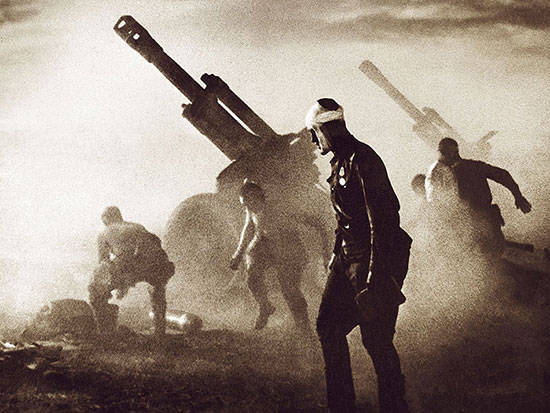
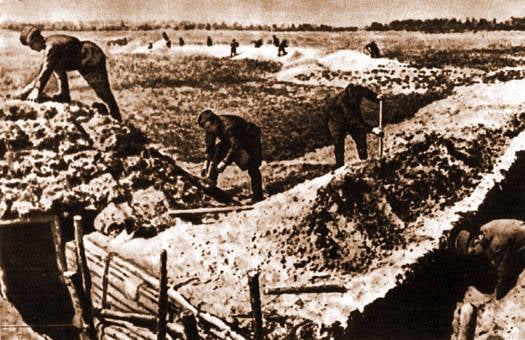
The construction of defensive lines. Kursk arc.
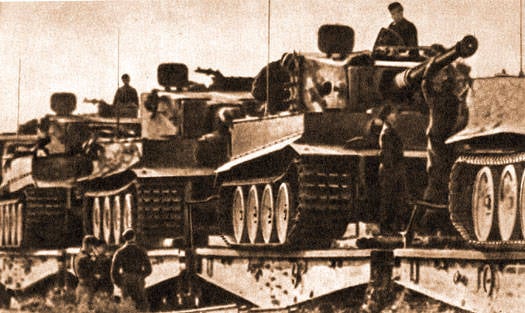
The transfer of Nazi troops in the area of the Kursk bulge.
Results
The defense is not the salvation of the army, when you can repel the blow of the enemy, having suffered small losses. This is the myth that created the cinema, showing how our infantry is crumbling the advancing Fritz, or our chains, destroyed by enemy machine-gun artillery fire, which the “stupid” commissars have attacked.
The attacker has a strategic initiative, the enemy does not know his plans. The attacking side can mix the defending side with the ground with the help of artillery and aircraft. Barbed wire swept artillery and mortar fire, artillery and mortars pierce passages in minefields, destroy long-term firing points. The artillery of the defending side is suppressed, since they have the opportunity to gather superior forces on this site. Then, under the cover of a rampart, tanks and infantry attack. The attacking side can create full numerical superiority when a regiment attacked by a full-blooded division with tank units, thwarted by aviation and artillery. As a result, the front breaks, the neighboring parts, in order not to get into the environment, begin to depart.
The attacking side, which is well prepared, cannot be stopped by more powerful fortifications than the field ones. The Wehrmacht broke the "Maginot Line" on the border with France, the Red Army broke into the fortifications of the "Mannerheim Line".
Soviet assault group is moving to the Reichstag.
Sources of:
Isaev A. Antisuvorov. Ten myths of the Second World War. M. 2006.
Zhukov G. K. Memoirs and reflections. In 2 volumes. M., 2002.
Karpov V.V. Selected Works. In 3 volumes. M., 1990.
Konev I.S. Notes of the front commander. M., 2000.
Kursk battle. M., 1970.
Mikhailov I. Environment under Vyazma. Vyazma. 1999.
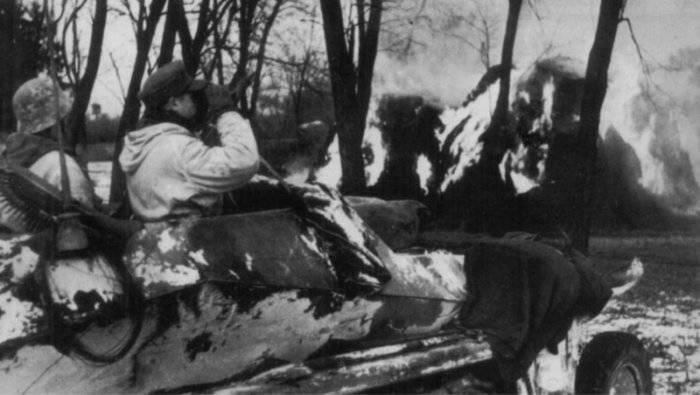
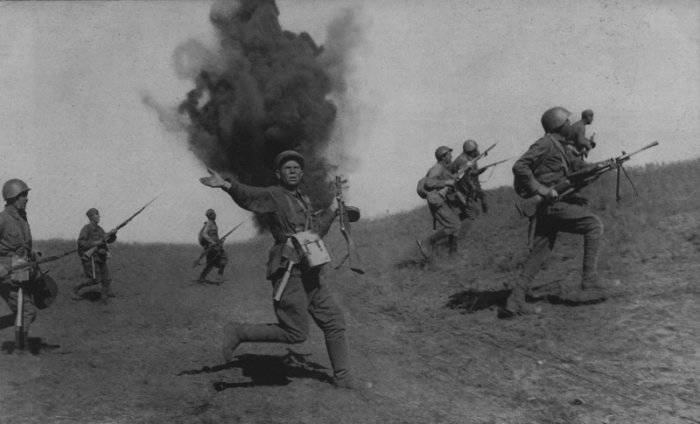
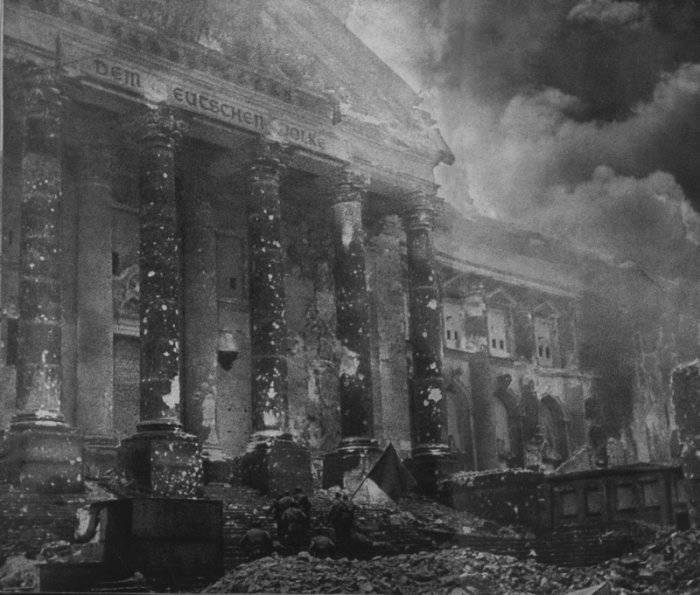
Information